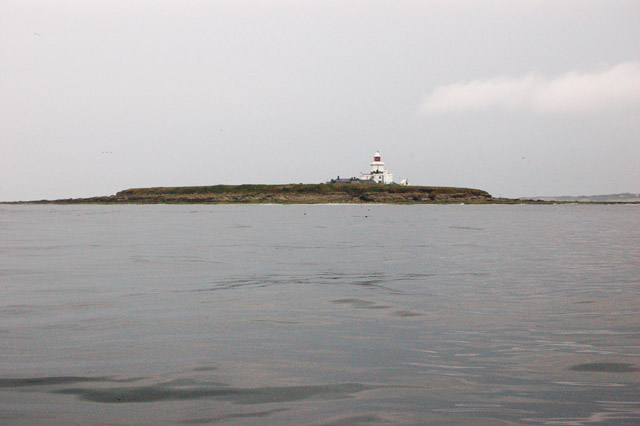Topics > Northumberland > Coquet Island > The Hermit of Coquet Island
The Hermit of Coquet Island
Extract from: John Crawford Hodgson, "A History of Northumberland. Issued under the direction of the Northumberland County History Committee.", 1899, pp 136-8:
The legend of St. Henry of Coquet, in the beginning of the twelfth century, is in complete harmony with the weird character of the island. A Dane of noble birth, "he is said to have been directed by a vision to make good his escape from a marriage his parents were endeavouring to force upon him, and to serve God all his days as a hermit on this particular rock." He landed at Tynemouth, and obtained the prior's consent to build a small cell on the island, which was in the charge of one of the monks. For some years he allowed himself a little loaf and a draught of water every day: afterwards he took food only thrice a week, and gave up speaking for three years. During the last four years of his life he ground his barley into meal with a mill-stone, and after moistening it with water, made it into little round cakes that he dried in the sun. His privations brought upon him many harsh words and opprobrious epithets from the monk in charge of the island. His relations sent to urge his return to Denmark, pointing out that there were plenty of wild spots there suitable for a hermitage. He threw himself on his knees before his crucifix, and believed that he heard the Christ command him to remain to the end in his Northumbrian cell. He regarded a loathsome affection of one of his knees as a further sign forbidding his departure. Supporting himself on a crutch, he still insisted on digging his little field; his crops were marvellous. Like St. Cuthbert, he was credited with second sight: the monk, his persecutor, found him praying before the altar for the soul of his half-brother, of whose murder in Denmark he had a presentiment that proved well founded. Another day, as some merchantmen were sailing smoothly past the island, he said to some of the numerous visitors that hermits invariably attract, "Do you not see the monster following those ships?" They then perceived the figure of a woman gliding in a cloud on the sea. "That woman," he continued, will presently strike the sea and raise a storm that will engulf the vessels and most of their crews.' Before long came the news that the ships had indeed been driven on the sands and rocks, nearly all hands being lost. We are not told that the saint essayed to exorcise the fatal phantom; a mariner subsequently ascribed his escape from shipwreck to St. Henry's intercession. A drunken monk of Tynemouth was dumbfounded when “the hermit of Coquet Isle” named the place and the hour of his last debauch. A priest in the immediate neighbourhood was lying dangerously ill: as St. Henry approached his house he heard the demons gloating over their sure possession of his soul, alleging the priest had only done one good deed in all his life. With some difficulty he convinced them that the one good deed was of such a nature as to outweigh all the bad ones ; such was their disappointment that the demons placed no further hindrance in the way of the priest's recovery and reformation. Except for a pilgrimage to Durham, to the shrine of the saint he strove to emulate, this is the only mention of St. Henry quitting his island.
In the winter of 1126-1127, the pain caused by his ulcerated knee became intense, but St. Henry would not allow any one to enter his cell. He passed the cold days and long nights all alone, without fire or light, in cheerful contentment. On Sunday, the 16th of January, a man on the island thought he heard two choirs of angels in the air chanting alternate verses of the Te Deum. The hymn ceased, the hermit's bell rang; the monk of the island hastened to the cell and found St. Henry seated on a stone holding the bell-rope, in all the calm of sleep - life had passed away, a mortuary candle that the saint had had no means of lighting was burning at his side. After a very necessary ablution, the body acquired the whiteness of snow. The parishioners were determined to place it in a shrine in their own church, no doubt at Warkworth. As they were conveying it to the mainland a thick fog lowered over the sea and they lost their way. They landed near another church, perhaps that of Woodhorn, in which the body rested that night. St. Henry, it was declared, now appeared in a vision and directed that it should be carried to Tynemouth the first thing the next morning before the neighbourhood had time to reassemble and defend what they regarded as their precious heritage. At Tynemouth the monks buried it with all honour a little to the south of St. Oswin's shrine.

from https://archive.org/stream/hi…
A history of Northumberland. issued under the direction of the Northumberland county history committee
- Hodgson, John Crawford. "A History of Northumberland Volume V : The Parish of Warkworth, the Parish of Shilbottle, the Chapelry or Extra-Parochial Place of Brainshaugh." Andrew Reid & Company Limited, …
Added by
Simon Cotterill


from https://archive.org/stream/hi…
A history of Northumberland. issued under the direction of the Northumberland county history committee
- Hodgson, John Crawford. "A History of Northumberland Volume V : The Parish of Warkworth, the Parish of Shilbottle, the Chapelry or Extra-Parochial Place of Brainshaugh." Andrew Reid & Company Limited, …
Added by
Simon Cotterill







